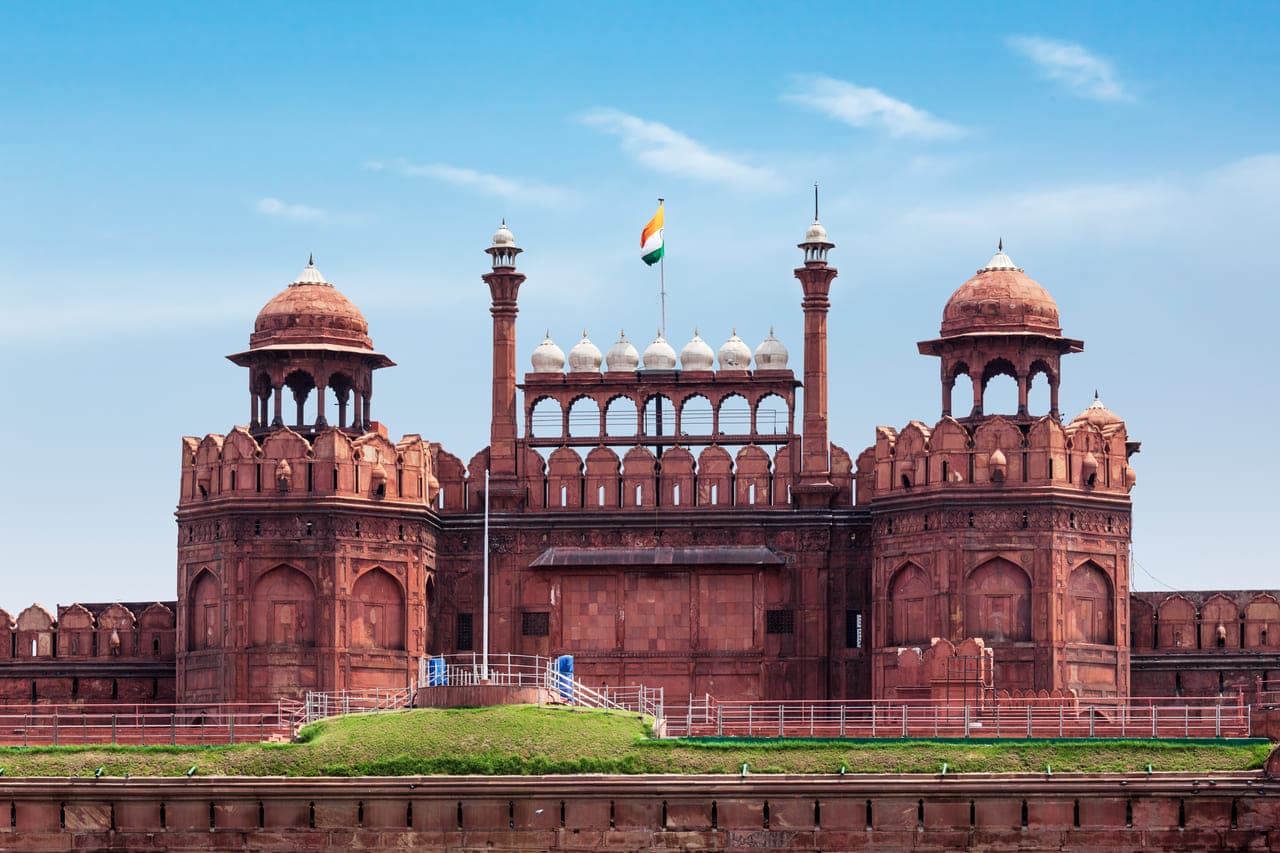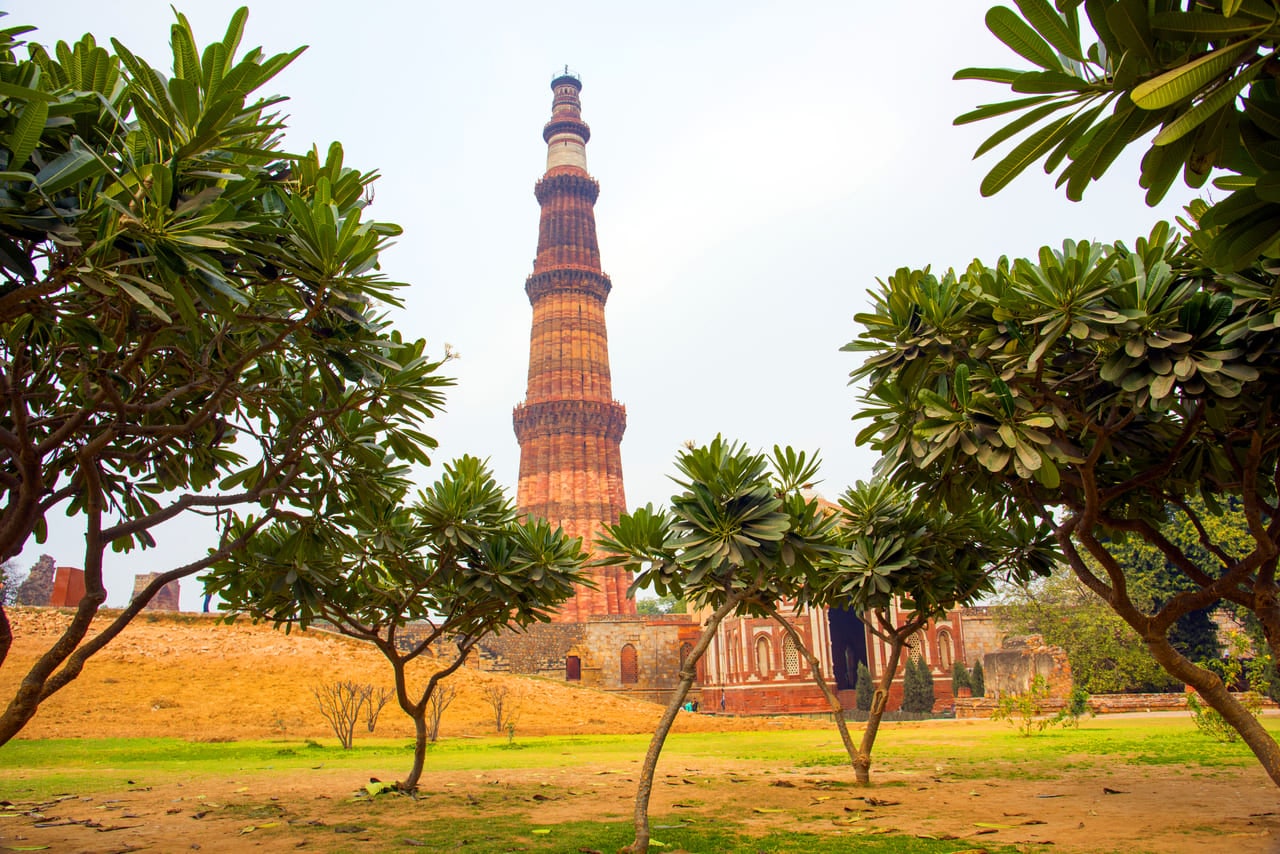Overview of Delhi
Delhi is a city and a union territory in India. It includes New Delhi which is the capital of India. Delhi is situated beside the Yamuna River and borders Uttar Pradesh and Haryana.
Delhi covers an area of 1,484 square kilometers and became a union territory in 1956 and was renamed National Capital Territory (NCT) in 1995.
Including Noida and Gurgaon the entire National Capital Region (NCR) has 28 million people, the largest in India.
Delhi is the political, cultural and economic hub of India. It experiences an extreme climate with hot summers, cold winters, and a monsoon season.

History of Delhi
Delhi has been rich history an important political center in India. Its story begins with the ancient city of Indraprastha mentioned in Mahabharata. Fast forward to 1192 when Muhammad of Ghori captured Delhi and established the Delhi Sultanate. This marked the beginning of Muslim rule in the region.
In 1398 Timur invaded Delhi and ended the Sultanate. This led to the rise of the Mughal Empire in 1526 founded by Babur after the Battle of Panipat. Early Mughal rulers preferred Agra but Shah Jahan moved the capital back to Delhi in 1638 and built the walls of Old Delhi.
The city came under British rule in 1803. In 1911 the British shifted their capital from Calcutta to Delhi and it became the political center again. After India got independence in 1947 New Delhi was declared the capital of India.

Population and Demographics of Delhi
As of 2024 Delhi’s population has grown to about 2.08 crores (20.8 million) from 1.68 crores (16.8 million) in 2011. The city is very crowded with a population density of 29,259.12 people per sq mile, one of the highest in the world!
Indo-Aryan is the largest ethnic group in Delhi (72%), followed by Dravidian (25%) and Mongoloid and other groups (3%). There are less women than men, 866 women for every 1000 men. Literacy rate is high, 86% with 91% men and 81% women can read and write.
Hindi is the main language spoken by 81% of the people, Punjabi 7% and Urdu 6%. Most of the people in Delhi are Hindus (82%) while 12.86% are Muslims. Some people also follow Christianity (0.87%) and Buddhism (0.11%).
Administration and Society of Delhi
Delhi, the National Capital Territory (NCT), has its own government. It includes a Legislative Assembly where members are voted in by the people. The Chief Minister leads this assembly. Helping the Chief Minister is the Lieutenant Governor and a council of ministers.
Administrative Divisions
The NCT of Delhi has 11 districts, 33 subdivisions, 59 census towns, and 300 villages. The 11 districts are:
- Central Delhi
- East Delhi
- New Delhi
- North Delhi
- North East Delhi
- North West Delhi
- Shahdara
- South Delhi
- South East Delhi
- South West Delhi
- West Delhi
Delhi is split into three main municipalities:
- Municipal Corporation of Delhi (MCD): This is the largest, covering an area of 1,397.3 square kilometers. It’s divided into 12 zones like Center, South, West, and Rohini. Shelly Oberoi has been the mayor since 2023.
- New Delhi Municipality: This area covers 42.7 square kilometers and includes important government buildings and embassies.
- Delhi Cantonment: Covering 42.3 square kilometers, this area is mainly for military purposes.
MCD divided into three separate corporations:
- South Delhi Municipal Corporation (SDMC): Managed South and West Delhi areas like Mahipalpur, Rajouri Garden, Uttam Nagar, and Greater Kailash.
- North Delhi Municipal Corporation (NDMC): Covered areas such as Badli, Chandni Chowk, Karol Bagh, and Model Town.
- East Delhi Municipal Corporation (EDMC): Took care of places like Patparganj, Laxmi Nagar, Seemapuri, and Shahdara.

Top Tourist Attractions of Delhi
Delhi is a super cool city with lots of awesome places to visit. You can explore ancient forts, beautiful tombs, and modern museums. There’s something for everyone. Here are some top tourist attractions in Delhi :
- India Gate: Located in the heart of New Delhi, India Gate is a grand war memorial built to honor Indian soldiers who died in World War I. The nearest metro station is Central Secretariat.
- Red Fort: One of the most famous landmarks in Delhi, the Red Fort was built in the 17th century by Emperor Shah Jahan. This stunning fort made of red sandstone is located in Old Delhi. The nearest metro station is Chandni Chowk.
- Humayun’s Tomb: This impressive tomb was built in the 16th century for the Mughal Emperor Humayun. It’s a fantastic example of Mughal architecture and a UNESCO World Heritage Site. The nearest metro station is JLN Stadium.
- Lotus Temple: The Lotus Temple, shaped like a giant lotus flower, is a Bahá’í House of Worship open to people of all religions. It’s located in South Delhi. The nearest metro station is Kalkaji Mandir.
- National Museum, New Delhi: This massive museum houses artifacts from all over India. It’s located on Janpath Road, near Rajpath. The nearest metro station is Udyog Bhawan.
- Rashtrapati Bhavan: This is the official residence of the President of India. It’s a grand building located at the end of Rajpath in New Delhi. The nearest metro station is Central Secretariat.
- Qutub Minar: This soaring tower, built in the 12th century, is the tallest brick minaret in the world. Located in Mehrauli, the nearest metro station is Qutub Minar.
- National Rail Museum: If you love trains, this museum is a must-visit. Located in Chanakyapuri, it showcases India’s railway history. The nearest metro station is Dhaula Kuan.
- Rajghat: This is a memorial dedicated to Mahatma Gandhi. It’s a peaceful place located near the Yamuna River. The nearest metro station is ITO.

Places to Visit in Delhi
Delhi is an exciting city with so many fun places to explore. From beautiful temples and gardens to bustling markets and cool museums, there’s always something awesome to see and do. Here are some great places you should definitely visit:
- Akshardham Temple is a stunning temple with amazing architecture located in East Delhi. The nearest metro station is Akshardham.
- The National Gallery Of Modern Art showcases incredible art from around the world. It’s located near India Gate in New Delhi. The nearest metro station is Khan Market.
- Garden of Five Senses is a beautiful park where you can enjoy nature and fun activities. It’s in South Delhi, and the nearest metro station is Saket.
- Lodhi Garden is perfect for a peaceful walk among historic tombs and lush greenery. It’s located in Central Delhi, and the nearest metro station is Jor Bagh.
- Dilli Haat is a lively market with crafts, food, and cultural performances. It’s in South Delhi, and the nearest metro station is INA.
- Chandni Chowk is a super busy and famous market in Old Delhi, full of delicious street food and shops. The nearest metro station is Chandni Chowk.
- Bharat Darshan Park features mini replicas of famous Indian monuments. It’s in Punjabi Bagh, West Delhi, with the nearest metro station being Punjabi Bagh West.
- Gurudwara Bangla Sahib is a serene and beautiful Sikh temple in Connaught Place. The nearest metro station is Rajiv Chowk.
- Delhi Zoo is home to lots of different animals and is located near Purana Qila in Central Delhi. The nearest metro station is Pragati Maidan.
- Mehrauli Archaeological Park has ancient ruins and monuments to explore. It’s located in South Delhi, and the nearest metro station is Qutub Minar.
- Mughal Gardens at Rashtrapati Bhavan are open to the public during certain months and offer stunning floral displays. The nearest metro station is Central Secretariat.
- Kingdom Of Dreams is a fun-filled entertainment complex with live shows and cultural experiences. It’s located in Gurgaon, just outside Delhi. The nearest metro station is IFFCO Chowk.
- Connaught Place is a popular shopping and dining area in New Delhi. The nearest metro station is Rajiv Chowk.
- ISKCON Temple Delhi is a beautiful temple dedicated to Lord Krishna, located in East of Kailash. The nearest metro station is Nehru Place.
- Khan Market is a trendy market with lots of cool shops and eateries in Central Delhi. The nearest metro station is Khan Market.
- Birla Mandir Delhi (Laxmi Narayan Temple) is a lovely Hindu temple near Connaught Place. The nearest metro station is RK Ashram Marg.
- Lajpat Nagar is a bustling market in South Delhi with lots of clothes and accessories. The nearest metro station is Lajpat Nagar.
- Pragati Maidan hosts many big exhibitions and fairs throughout the year. It’s located in Central Delhi, and the nearest metro station is Pragati Maidan.

Facts About Delhi
- Delhi is the capital of India and is officially known as the National Capital Territory (NCT) of Delhi.
- Delhi is located in Northern India at 28.61°N, 77.23°E. The city covers an area of 1,483 km² (573 sq mi).
- Delhi has the highest road density in India, with 2103 km of roads for every 100 km².
- The telephone code of Delhi is 011, and the PIN codes range from 110001 to 110099.
- Delhi is in the Indian Standard Time zone, which is UTC+5:30.
- Delhi is the largest metropolitan area in India and the second-largest in the world.
- Some popular locations in Delhi include South Extension, Greater Kailash, Vasant Kunj, Defence Colony, Saket, Chittaranjan Park, Malviya Nagar, Hauz Khas, Green Park, Gulmohar Park, Preet Vihar, Mayur Vihar, Janakpuri, Paschim Vihar, Dwarka, Kirti Nagar, Rohini, Chanakyapuri, Patel Nagar, and Nehru Place.
- The ISO 3166 code for Delhi is IN-DL, and it’s governed by the Delhi Legislative Assembly.
- The main railway stations of Delhi are New Delhi, Old Delhi, Hazrat Nizamuddin, Anand Vihar, Delhi Sarai Rohilla, and Delhi Cantt.
- The Delhi Metro is a rapid transit system that serves Delhi, Ghaziabad, Faridabad, Gurgaon, and Noida. It was built and is operated by the Delhi Metro Rail Corporation Limited (DMRC).
- Delhi’s boundaries include nearby towns and cities like Faridabad and Gurgaon in Haryana, and Ghaziabad and Noida in Uttar Pradesh.
- Chandni Chowk, a 17th-century market, is one of the most popular shopping areas in Delhi.
- Delhi is home to some of India’s top universities, including the All India Institute of Medical Sciences, Indian Institute of Technology, University of Delhi, Jawaharlal Nehru University, Jamia Millia Islamia, and Guru Gobind Singh Indraprastha University.
- In 1911, New Delhi, a part of Delhi, became the capital of British India. It continued as the capital when India became a republic in 1950.
- Delhi ranks fourth among Indian states in the Human Development Index and has the second-highest GDP per capita in India, after Goa.
- The city houses important buildings like the Parliament of India, the Supreme Court, and the President’s official residence, Rashtrapati Bhavan.
- Delhi’s urban area includes nearby cities like Ghaziabad, Faridabad, Gurgaon, Noida and Greater Noida. This whole area is called the National Capital Region (NCR).
- Delhi is split into two parts – Old Delhi and New Delhi. Old Delhi has lots of historical places, while New Delhi is more modern.
- The NCR also includes tech hubs like Gurgaon and Noida, where many big companies have their offices. These cities are growing super fast!


